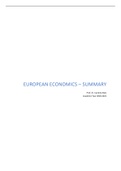EUROPEAN ECONOMICS – SUMMARY
Prof. dr. Caroline Buts
Academic Year 2020-2021
, CLASS 1 – CH 4: INTRODUCTION
INTRODUCTION
Book: Economics of European Integration
- Complement economic theories with empirical examples
- Additional optional readings: Pelckmans, more theoretical
Exam material: slides, book, guest lecture (1-2), student presentations
We will follow the structure of the book
- 5 parts
o Part 1: introduction to the EU
§ First 3 chapters of the book
o Part 2: microeconomics of economic integration
§ Lot of time
§ Already start today: main elements of free trade agreements, imposing
tariffs on some countries, not on others
o Part 3: policies (competition policy, agricultural policy, …)
§ Importance of solidarity mechanisms
o Part 4: macroeconomics of economic integration
§ European semester
§ Essential rules
o Part 5: monetary policy
§ Economic Crisis of 2010 and how this improved our macroeconomic policy
coordination
§ What we learned from the Crisis
More in detail à look at the preliminary schedule
OVERVIEW OF THE CLASSES
Today: Ch. 4 and 5
- Important: Ch 4: not directly for the exam, but the tools we need for all the other chapters
o Basic demand-supply mechanisms, import demand, export supply, tariff and what it
does to welfare
o Never on exam: what is a demand curve, consumer surplus
§ But to apply it in the later chapters
- Ch 5: liberalization in the preferential way
o Starting from free trade world à imposition of tariff on imports & exports à looking
at the EU (all other trade agreements in the world) à what happens if a group of
countries decides to liberalize trade, not with the entire world, but with a number of
countries, while other countries are still subject to tariffs
2
,Ch 5-6: growth effects of integration: factor market integration (?)
- All economic rationales regarding integration projects: how they work in theory and whether
they match reality
12/10: build on this and dive into labor market integration
- What happens if we take it a step further
- Free migration of labor and goods
- And how this benefits the market in theory
- Also group-formation exercise
o Group-work
o Fill out questionnaire to find out role and teachers will compose groups
o E.g. company worker, creator, chair …
o Different roles come together to form the perfect team
19/10: Monday no class à replaced by guest lecture on Wednesday 21/10
- Guest lecture about the European Semester, Commissioner speaking
- Via Teams
Afterwards: more policy-related chapters
- Cover different policies (CAP, regional policy, etc.)
23/11: no class
Week 7 & 9: Then, macroeconomics part
- Cover basics and start the presentations in the final weeks
Group work: structure with break-out rooms on Teams
- Every group has name and room, Buts drops in each group for questions etc.
Visit to the EU Parliament
- Large group visits are not allowed yet
o Visit in small groups
o Groups up to 10 ppl
CLASS RULES
- Try to always attend live and participate to the discussion
- Interrupt to ask questions
o Step-by-step to build graphs, draw them together
- There will be some classes with shorter time for the class
- Encourage to make it a zen-moment
o Try not to be distracted
3
, GRADING
Two important parts
- Presentation (25% of grade)
o Half October with group formation
- Written exam (75% of grade)
o Book, slides, lectures (also guest lectures)
o Open questions à choose 2 out of 3 questions
Usually more slides than we cover in class
- Slides we won’t cover à important for general understanding and to fully grasp the book
- The slides we cover together are exam material, the others not so much
BRAINSTORM
ECB
- European Central Bank
- Macroeconomic policy
o Monetary policy
§ Country will change the interest rates
§ Increase: more difficult to take out loans à slow down economy
§ Lower: cheaper to get a loan à boost economy
o Fiscal policy à taxes
§ Lower à boost economy
§ Higher à slow down economy
- Countries that chose to introduce euro à surrendered their monetary policy to the ECB
o They still have their fiscal policy tho
§ Can still play with taxes
o Cannot decide on their own the interest rates anymore
§ Set by the ECB
- Located in Frankfurt
- They set one interest rate for the entire Eurozone
o If you have diff economic circumstances in diff MS, you can still only set one interest
rate
o It’s a coordination for the Eurozone, but very difficult to cater to diff circumstances
o Cfr. prelude to the Crisis
§ Too high for Germany, too low for Spain and Ireland which were fostering a
housing bubble
European taxes
- Fiscal policy has an automatic part
o Economic slowdown: tax revenue is less
- Also tax rates that you can set
o MS still have quite a lot of jurisdiction to set tax levels
§ Companies that operate in diff MS are subject to diff tax levels
4





